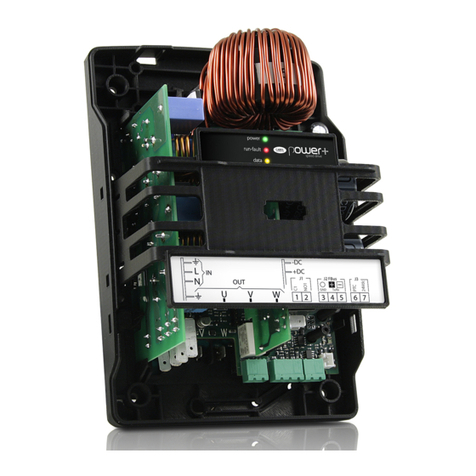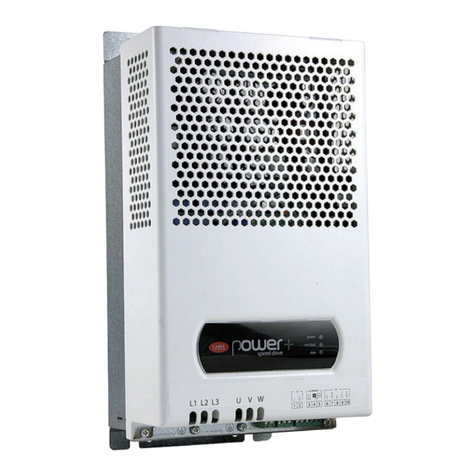
ENG
“Power+” +0300050EN - rel. 2.3 - 08.06.20123
WARNINGS
CAREL bases the development of its products on decades of experience
in HVAC, on the continuous investments in technological innovations
to products, procedures and strict quality processes with in-circuit and
functional testing on 100% of its products, and on the most innovative
production technology available on the market. CAREL and its subsidiaries
nonetheless cannot guarantee that all the aspects of the product and the
software included with the product respond to the requirements of the
nal application, despite the product being developed according to start-
of-the-art techniques.
The customer (manufacturer, developer or installer of the nal equipment)
accepts all liability and risk relating to the conguration of the product
in order to reach the expected results in relation to the specic nal
installation and/or equipment.
CAREL may, based on specic agreements, act as a consultant for the
positive commissioning of the nal unit/application, however in no case
does it accept liability for the correct operation of the nal equipment/
system.
The CAREL product is a state-of-the-art product, whose operation is
specied in the technical documentation supplied with the product or
can be downloaded, even prior to purchase, from the website www.CAREL.
com.
Each CAREL product, in relation to its advanced level of technology,
requires setup / conguration / programming / commissioning to be
able to operate in the best possible way for the specic application. The
failure to complete such operations, which are required/indicated in the
user manual, may cause the nal product to malfunction; CAREL accepts
no liability in such cases.
Only qualied personnel may install or carry out technical service on the
product.
The customer must only use the product in the manner described in the
documentation relating to the product.
In addition to observing any further warnings described in this manual, the
following warnings must be heeded for all CAREL products:
• Prevent the electronic circuits from getting wet. Rain, humidity and
all types of liquids or condensate contain corrosive minerals that may
damage the electronic circuits. In any case, the product should be
used or stored in environments that comply with the temperature and
humidity limits specied in the manual.
• Do not install the device in particularly hot environments. Too high
temperatures may reduce the life of electronic devices, damage them
and deform or melt the plastic parts. In any case, the product should be
used or stored in environments that comply with the temperature and
humidity limits specied in the manual.
• Do not attempt to open the device in any way other than described in
the manual.
• Do not drop, hit or shake the device, as the internal circuits and
mechanisms may be irreparably damaged.
• Do not use corrosive chemicals, solvents or aggressive detergents to
clean the device.
• Do not use the product for applications other than those specied in
the technical manual.
All of the above suggestions likewise apply to the controllers, serial boards,
programming keys or any other accessory in the CAREL product portfolio.
CAREL adopts a policy of continual development. Consequently, CAREL
reserves the right to make changes and improvements to any product
described in this document without prior warning.
The technical specications shown in the manual may be changed without
prior warning.
The liability of CAREL in relation to its products is specied in the CAREL
general contract conditions, available on the websie www.CAREL.com and/
or by specic agreements with customers; specically, to the extent where
allowed by applicable legislation, in no case will CAREL, its employees
or subsidiaries be liable for any lost earnings or sales, losses of data and
information, costs of replacement goods or services, damage to things
or people, downtime or any direct, indirect, incidental, actual, punitive,
exemplary, special or consequential damage of any kind whatsoever,
whether contractual, extra-contractual or due to negligence, or any other
liabilities deriving from the installation, use or impossibility to use the
product, even if CAREL or its subsidiaries are warned of the possibility of
such damage.
NO POWER
& SIGNAL
CABLES
TOGETHER
READ CAREFULLY IN THE TEXT!
WARNING:separate as much as possible the probe
and digital input signal cables from the cables carrying
inductive loads and power cables to avoid possible
electromagnetic disturbance. Never run power cables
(including the electrical panel wiring) and signal cables
in the same conduits
Approval: the quality and safety of CAREL products are
guaranteed by the ISO 9001 certied design and
production system, as well as by the and
marks.
DISPOSAL
INFORMATION FOR USERS ON THE CORRECT HANDLING OF WASTE
ELECTRICAL AND ELECTRONIC EQUIPMENT (WEEE)
In reference to European Union directive 2002/96/EC issued on 27 January
2003 and the related national legislation, please note that:
• WEEE cannot be disposed of as municipal waste and such waste must be
collected and disposed of separately;
• the public or private waste collection systems dened by local legislation
must be used. In addition, the equipment can be returned to the
distributor at the end of its working life when buying new equipment;
• the equipment may contain hazardous substances: the improper use or
• incorrect disposal of such may have negative eects on human health
and on the environment;
• the symbol (crossed-out wheeled bin) shown on the product or on the
• packaging and on the instruction sheet indicates that the equipment
has been introduced onto the market after 13 August 2005 and that it
must be disposed of separately;
• in the event of illegal disposal of electrical and electronic waste, the
penalties are specied by local waste disposal legislation.
SYMBOLS
Dangerous voltage
Caution, hot surface
Important: brings critical subjects regarding use of the product to the user’s
attention
Note: when attention must be given to subjects of relevant importance, in
particular regarding practical use of the various product functionality.






























